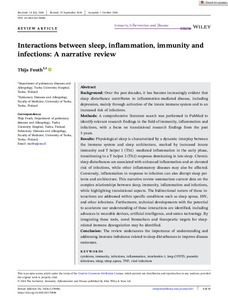Interactions between sleep, inflammation, immunity and infections: A narrative review
Feuth, Thijs
https://urn.fi/URN:NBN:fi-fe2025082787761
Tiivistelmä
Background: Over the past decades, it has become increasingly evident thatsleep disturbance contributes to inflammation‐mediated disease, includingdepression, mainly through activation of the innate immune system and to anincreased risk of infections.Methods: A comprehensive literature search was performed in PubMed toidentify relevant research findings in the field of immunity, inflammation andinfections, with a focus on translational research findings from the past5 years.Results: Physiological sleep is characterized by a dynamic interplay betweenthe immune system and sleep architecture, marked by increased innateimmunity and T helper 1 (Th1) ‐mediated inflammation in the early phase,transitioning to a T helper 2 (Th2) response dominating in late sleep. Chronicsleep disturbances are associated with enhanced inflammation and an elevatedrisk of infections, while other inflammatory diseases may also be affected.Conversely, inflammation in response to infection can also disrupt sleep pat-terns and architecture. This narrative review summarizes current data on thecomplex relationships between sleep, immunity, inflammation and infections,while highlighting translational aspects. The bidirectional nature of these in-teractions are addressed within specific conditions such as sleep apnea, HIV,and other infections. Furthermore, technical developments with the potentialto accelerate our understanding of these interactions are identified, includingadvances in wearable devices, artificial intelligence, and omics technology. Byintegrating these tools, novel biomarkers and therapeutic targets for sleep‐related immune dysregulation may be identified.Conclusion: The review underscores the importance of understanding andaddressing immune imbalance related to sleep disturbances to improve diseaseoutcomes.
K E Y W O R D Scytokines, immunity, infections, inflammation, interleukin‐1, long‐COVID, parasiticinfections, sleep, sleep apnea, TNF, viral infectionsImmun
Kokoelmat
- Rinnakkaistallenteet [27094]
